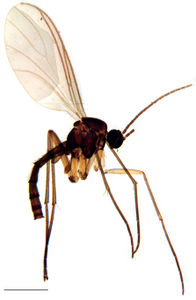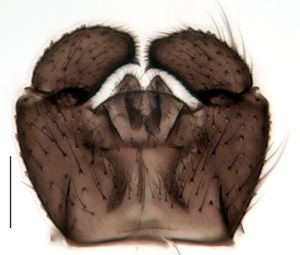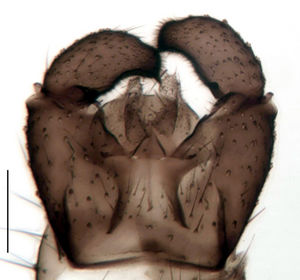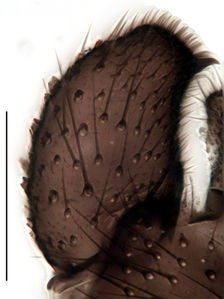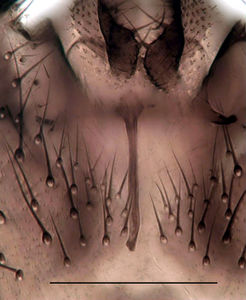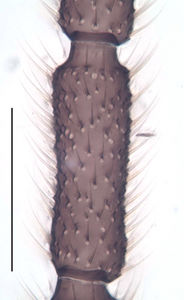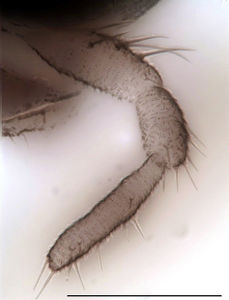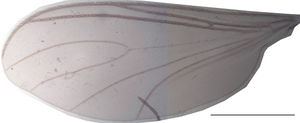Trichosiopsis fuscipalpa
Ordo: Diptera
Familia: Sciaridae
Genus: Trichosiopsis
Name
Trichosiopsis fuscipalpa (Mohrig & Mamaev, 1979) – Wikispecies link – ZooBank link
- Trichosia (Leptosciarella) fuscipalpa Mohrig & Mamaev, 1979[1]: 575-576, fig. 4
- Leptosciarella (Leptosciarella) fuscipalpa (Mohrig & Mamaev, 1979)[2]: 64-66, fig. 12
Type material
Holotype: ♂, no date, leg. Mamaev in PWMP
Type locality
Russia, Danki near Moscow
Material studied
Denmark: 1 ♂, Fynshav, Alsen, old beech forest, sweep netting, Heller, 17.05.2007, PKHH 5561; Finland: 1 ♂, Ks, Hangasjoki, Salmela, 03.08.2005, MZH 9239; 2 ♂, Le, Kilpisjärvi, Jakovlev & Penttinen, 2006, MZH 9237; 3 ♂, Tb, Kolari, Konnevesi, Korpi jakso 9, Penttinen, MZH 9232-9234; 1 ♂, Kb, Koli, Pielisjärvi, grassy birch forest at former slash and burn site, sweep netting, Jaschhof, 10.06.2004, PKHH 6239; 5 ♂, Li, Utsjoki, Tundra, Malaise trap, Fatouros, 26.6.-03.07.2000, PKHH 3258/3961-3964; 1 ♂, 3.-10.07.2000, PKHH 3966; 2 ♂, 17.-26.06.2000, PKHH 3247/3965; 3 ♂, Lk, Yllästunturi, Kolari, Mannikko, Yakovlev & Penttinen, no date, MZH 9231/9235/9236; Germany: 1 ♂, Baden-Württemberg, Bad Rotenfels, Bannwald Birkenkopf, Malaise trap, Doczkal, 3.4.-03.05.2003, PKHH 5069; 1 ♂, 3.-17.05.2003, PKHH 7696; 6 ♂, Belchen, Malaise trap, Doczkal, 28.5.-03.07.2003, PKHH 4824/4851, PDDM 108, PASS 88; 1 ♂, Malsch, Heckelbachklamm, Malaise trap, Doczkal, 2.-21.06.2003, PKHH 7722; 1 ♂, Schelingen, beech forest, sweep netting, Heller, 28.05.2011, PKHH 7844; 1 ♂, Bavaria, Sonthofen, Hinang, Hinanger Wasserfälle, sweep netting, Heller, 29.05.2004, PKHH 4169; 1 ♂, St. Bartholomä, beech forest, sweep netting, Heller, 29.05.1999, PKHH 2818; 2 ♂, Schöngeising, Kellerbach, sweep netting, Schacht, 23.05.1992, ZSMC 179/192 [as Trichosia pilosa (Staeger, 1840) in Rudzinski (1994[3]: 208)]; 2 ♂, Brandenburg, Himmelpfort, Röschmann, 05.1991, PWMP 1751/1770 1 ♂, Lower Saxony, Braunlage, junger Ahorn-Mischwald, yellow pan trap, Heller, 21.-28.05.2006, PKHH 4728; 1 ♂, Mecklenburg-Vorpommern, Bobbin on Rugen, forest, Groth, 15.05.1985, PWMP 1644 [as Trichosia pilosa = Le. rejecta (part.) in Menzel et al. (1990[4]: 317)]; 1 ♂, Born-Mühle, Lembke, 25.05.1985, PWMP 1750; 1 ♂, Brohm, Brohmer Berge, Röschmann, 16.05.1992, PWMP 1752; 2 ♂, Elisenhain near Greifswald, Wald, Buche und Kiefer, yellow pan trap, Jaschhof, 6.-10.05.1993, PWMP 1762/1764; 1 ♂, Greifswald, Arboretum, Malaise trap, Mohrig, 2.-08.06.1996, PWMP 1763; 2 ♂, 24.5.-18.07.1997, PWMP 1262/1263; 4 ♂, 1.-23.06.1997, PWMP 1253-1256; 1 ♂, yellow pan trap, Rulik, 04.05.1997, PWMP 1264; 2 ♂, Neuer Friedhof, Malaise trap, Mohrig, 17.5.-01.06.1997, PWMP 1260/1261; 3 ♂, 1.-23.06.1997, PWMP 1257-1259; 4 ♂, Stadtgärtnerische Anlagen, yellow pan trap, Mohrig, 28.4.-16.05.1997, PWMP 1765-1768; 1 ♂, Röschmann, 05.1992, PWMP 1627 [as Leptosciarella rejecta in Mohrig & Menzel (1997[2]: 63)]; 1 ♂, Jettchenshof b. Malchin, Buchenwald Gülitzer Forst, Drews, 01.06.1985, PWMP 1761; 1 ♂, Karbow, Nadelwald: Fichte, yellow pan trap, Jaschhof, 8.-10.05.1994, PKHH 5358; 1 ♂ 1 ♀, NSG Galenbecker See, Fleetholz, Bruchwald mit Erle, Esche, Kreuzdorn, Eiche, Birke, sweep netting, Jaschhof, 05.05.1994, PWMP 1758; 4 ♂, Grünland Rasenschmielen-, Quecken-, Kohldistel-, Staudenflora, photoeclector, Jaschhof, 29.8.-10.10.1994, PWMP 1650/1756/1757/1772; 2 ♂, Wampen near Greifswald, Fichten-Mischwald, Jaschhof, 28.07.1993, PWMP 1721/4033; 1 ♂, North-Rhine-Westphalia, Köln-Poll, Garten, Malaise trap, Franzen, 3.-10.09.2002, ZSMC 2033; 1 ♂, 10.-17.09.2002, ZSMC 2046; 16 ♂, Rhineland-Palatine, Kirchheimbolanden, NSG Albertskreuz, Malaise trap, Doczkal, 23.5.-07.06.2002, PKHH 4889-4893; 1 ♂, Schleswig-Holstein, Aumühle, Sachsenwald, sweep netting, Heller, 24.06.1995, PKHH 1035; 1 ♂, Blumenthal, wood sample, beech and oak, photoeclector, Arp, 10.04-19.05.2000, PKHH 3129; 1 ♂, Flensburg, Marienhölzung, forest, Malaise trap, Berkemeyer, 31.05.-07.06.1996, PKHH 2040; 1 ♂, 23.-30.05.1997, PKHH 2909; 1 ♂, 30.05.-06.06.1997, PKHH 2897; 1 ♂, 21.-28.04.1999, PKHH 3088; 1 ♂, 09.-16.06.1999, PKHH 3085; 1 ♂, Heikendorf, Korügen, beech forest, sweep netting, Heller, 10.05.1991, PKHH 13; 2 ♂, 08.05.2011, PKHH 7816; 2 ♂, Schrevenborn, forest, sweep netting, Heller, 11.05.2003, PKHH 3978/3979; 1 ♂, Kiel, University, garden, Malaise trap, Heller, 05.-12.05.1995, PKHH 1016; 1 ♂, Kiel, Vieburger Gehölz, beech forest, sweep netting, Heller, 12.05.1996, PKHH 1386; 1 ♂, Pohnsdorf, beech forest, sweep netting, Heller, 06.05.2001, PKHH 3413; 3 ♂, Schönkirchen, Großholz, beech forest, sweep netting, Heller, 29.05.2003, PKHH 3995-3997; 1 ♂, Siggen, beech and oak forest, photoeclector, Tischler, 01.-15.06.1987, PKHH 566; 1 ♂, Sterley, beech forest, sweep netting, Heller, 21.05.1996, PKHH 1394; 17.05.2003, PKHH 3983; 1 ♂, Wankendorf, wood sample, beech, photoeclector, Warning, 24.04.-08.06.1989, PKHH 16; 1 ♂, Wankendorf, beech forest, photoeclector, Hingst, 15.04.-09.05.1989, PKHH 14/15; 2 ♂, 04.-18.05.1993, PKHH 613; 1 ♂, sweep netting, Heller, 5.-11.06.2006, PKHH 4772; 1 ♂, Thuringia, Hainich National Park, Craulaer Kreuz, beech forest, sweep netting, Heller, 18.06.2005, PKHH 4399; Hungary:1 ♂, Szilvasvarad, Heves, Galium-Fagaceen Wald, sweep netting, Rulik, 21.05.1998, PWMP 1769; Netherlands: 1 ♂, Haaksbergen, Haaksbergerveen; Hochmoor mit Laubwald (Stieleiche, Moorbirke, Erle, Weide Esche), sweep netting, Heller, 26.06.2010, PKHH 7658; 1 ♂, Tilburg, Kaaistoep, Malaise trap, v. Zuijlen, 25.4.-02.05.1998, PKHH 3769; 1 ♂, 2.-09.05.1998, PKHH 3765; 1 ♂, 23.-30.05.1998, NNKN 29; Norway: 3 ♂, Varanger Peninsula, Finmark, Vadsö, Laubwald, Birke, Zwergsträucher, Jaschhof, 12.07.1994, PWMP 1759/1760; Sweden: 1 ♂, Ångermanland, Skuleskogen National Park, Langra: brook ravine in mixed forest, Malaise trap, Swedish Malaise Trap Project, 24.7.-12.09.2005, NHRS 3709; 1 ♂, Bohuslän, Ödsmal, Västra Götalands län, Hällsberget, broad leaved deciduous forest, Malaise trap, Swedish Malaise Trap Project, 30.7.-11.08.2004, PKHH 5800; 12 ♂, Härjedalen, Nyvallen, Nyvallens fäbod: alpine birch and spruce wood, Malaise trap, Swedish Malaise Trap Project, 4.7.-04.08.2004, NHRS 1705/1756-1762/1770/4798/4800; 42 ♂, NHRS 3187-3197/3371-3377/4296-4304/5188-5193; 14 ♂, Öland, Skogsby, Gamla Skogsby (Kalkstad) "diversitetsängen", meadow with bushes, Malaise trap, Swedish Malaise Trap Project, 20.5.-28.06.2006, NHRS 2305-2310/2458/2503-2509; 21 ♂, Östergötland, Omberg, Östergötlands län, Boskogsreservatet Omberg: beech forest, Malaise trap, Swedish Malaise Trap Project, 28.5.-05.07.2005, NHRS 1515-1519/1544-1559; 13 ♂, Storpissan: old Norway spruce wood, Malaise trap, Swedish Malaise Trap Project, NHRS 3549-3552/2046-2052/2130/2131; 9 ♂, 3.3.-28.05.2005, NHRS 1831-1837/1960/1961; 1 ♂, Skåne, Mölle, Kullabergs naturreservat, Oak forest in southern slope, Malaise trap, Swedish Malaise Trap Project, 9.8.-20.09.2005, NHRS 2236; 3 ♂, Skåne, Simrishamn, Stenshuvud National Park: Svabeholmsskog, hornbeam forest, Malaise trap, Swedish Malaise Trap Project Project, 22.5.-20.06.2005, PKHH 7229/7232/7249; 2 ♂, 20.-26.06.2005, PKHH 6668/6669; 1 ♂, Småland, Bäckebo, Grytsjöns naurreservat, Old moisty haymaking meadow in forest edge, Malaise trap, Swedish Malaise Trap Project, 18.5.-15.06.2006, PKHH 6873; 1 ♂, 27.4.-18.05.2006, PKHH 7320/7321; Bäckebo, Grytsjöns naturreservat, Old aspen forest in boulder terrain, Malaise trap, Swedish Malaise Trap Project, 21.4.-18.05.2006, PKHH 7313; 4 ♂, Gränna, Lönnemålen, next to old cellar; Norway spruce forest with big harvested ashes, Malaise trap, Swedish Malaise Trap Project, 10.-24.09.2003, NHRS 3612-6314/3997; 1 ♂, Södermannland, Nämdö, Krokudden, Krokvik, spruce and pine forest, Malaise trap, Swedish Malaise Trap Project, 5.7.-07.08.2008, NHRS 4242; 14 ♂, 10.4.-23.05.2009, NHRS 4707-4721/4908-4914; 6 ♂, 23.5.-29.07.2009, NHRS 5112/5159/5172/5160-5163; 1 ♂, Torne lappmark, Nikkaluokta, Norrbottens län, young birch/willow forest along stream, Malaise trap, Jaschhof & Jaschhof, 14.7.-05.08.2005, NHRS 1073; 5 ♂, Uppland, Älvkarleby, Batfors, pine forest with blueberry, Malaise trap, Swedish Malaise Trap Project, 27.6.-01.07.2004, NHRS 4587/5491, PKHH 7458; 1 ♂, Lövstabruk, Malaise trap, Hippa & Gustavsson, 9.-12.06.1992, NHRS 20; 2 ♂, Uppland, Stockholm, Djurgården Park, pitfall trap, Kronestedt, 15.-29.06.1992, NHRS 557/558; 13 ♂, Malaise trap, Heinakroon, 02.-16.05.1994, NHRS 9/12/13/14199/201/204-206/211/215/216/220/362/364/369/370; 2 ♂, 16.-31.05-1994, NHRS 203/520; 7 ♂, 31.05.-13.06-1994, NHRS 351/352/505/600/607/669/670; 40 ♂, 31.5.-13.06.1994, NHRS 616/620/621/623/633/652/660-662/666/676-679/683/685/686/689/690/693/694/698/699/703-705/870-872/879/896/900-904/909/912/916/918; Switzerland: 1 ♂, Zurich, Sihlwald, window trap, Schiegg, 24.05.-05.06.1996, PKHH 1811; 2 ♂, photoeclector, 24.05.-19.06.1996, PKHH 2443/2452; Ukraine: 1 ♂, Kwasy, mixed forest, sweep netting, Mamaev, 22.06.1963, PWMP 1753; 1 ♂, 13.06.1963, PWMP 1754. .
Description (male)
Head. Eye bridge 4 rows of facets. LW-index of 4th antennal flagellar segment 2.5–3; neck 0.32–0.41 of segment width; Transition of basal part to neck pronounced. Colour of neck unicolour. Antennal hairs as long as segment width; sparse; salient. Palps darkened; normal, or long; palpomeres 3. First palpomere of normal shape; with 5–8 bristles; with only some sparse sensillae. Second palpomere shortly oval. Third palpomere as long as first segment. Thorax. Colour brown. Notum unicolorous. Thoracic setae long and strong, or normal; dark, or of different colours. Mesonotum with some weaker central bristles. Posterior pronotum bare, or setose. Postpronotal setae 0–4; fine. Laterotergite bare. Legs. Colour yellow. Hind coxae of same colour as femora. Hairs on fore coxae black. Front tibia apically with a patch of setae. Front tibial organ dark. Front tibial organ not bordered. Tibial setae on hind legs weak, inconspicuous, or normal, shorter than tibial width. Tibial spurs of equal length. Claws untoothed. Wings. Wings slightly darkened; of normal shape, or reduced, with weakly developed anal lobe. Wing membrane without macrotrichia. Wing venation weak, with faint m-base. M-fork of normal shape. R1 inserting clearly after base of m-fork, or inserting at or slightly before base of m-fork; posterior veins with macrotrichia; stM mainly with macrotrichia; cuA1 and cuA2 mainly with macrotrichia; bM bare; r-m bare, or with a few setae; bM:r-M 0.6–0.8; st-Cu:bM 0.6–0.75; r1:r 1.6–1.85; C:w 0.76–0.85. Halteres dark; of normal length. Abdomen. Abdominal setae strong and dense; dorsally dark; ventrally dark. Hypopygium concolour with abdomen; 0.55–0.75 × longer than wide. Base of gonocoxites with normal, weak hairs; gonocoxites broadly separated, or narrowly separated; inner margin of gonocoxites normally U-shaped; inner part of hypopygium scarcely setose; elongated setae on valves of hypopygium absent. Gonostylus 1.8–2.2 × longer than wide; apex equally rounded, or with one obtuse angle. Apical tooth present; 1.8–2.1 × longer than broad; normal. Awl-like setae normal; on inner side of gonostyles present apically. Megasetae on inner part of gonostylus absent. Whiplash-hair absent. Tegmen 0.54–0.65 × longer than broad; rectangular with rounded edges; normal; Central process absent. Length of aedeagus/hypopygium 33–45 %; Aeadeagal apical structure absent. Measurements. Body size 3–3.6 mm. Hind tibia 1.6–1.8 mm. Wing length 3.3–3.8 mm.
Diagnosis
Trichosiopsis fuscipalpa is a medium sized, slender species. It can be readily recognized by the long, tiny, yellow legs and long abdomen and by the large and broad wings with a reduced anal lobe. By the shape of the male genitalia Tr. fuscipalpa is similar to Trichosiopsis rejecta, Trichosiopsis defecta and Trichosiopsis finjae, having an obtuse angle on the outer side of the gonostyles above the apical tooth. It differs from these species by the longer antennae, the basally more rounded gonostyles and the not elongated hairs at the base of the hypopygium. The variant with broader form of the gonostyles with a less distinct apical angle (Fig. 2) reminds of species of the Tr. dimera complex, especially Trichosiopsis viatica and Trichosiopsis subpilosa, which can be distinguished apart from the shorter antennae by the shorter palpi and the more setose bM vein respectively. Trichosiopsis cerifera, which has still longer antennae, can be distinguished by the more parallel gonostyli.
DNA Barcoding
The COI sequences are assigned to four different BINs:
- BIN BOLD:ACC1319 (average distance 0.13%, max. 0.31%, n=7, K2P: 3.69%)
- BIN BOLD:ACE2641 (average distance 0.06%, max. 0.15%, n=5, K2P: 6.62%)
- BIN BOLD:ACM7016 (average distance 0.27%, max. 1.12%, n=36, K2P: 3.69%)
- BIN BOLD:ACQ8733 (average distance 0.09%, max. 0.17%, n=11, K2P: 8.04%)
Discussion
The shape of the gonostylus in Tr. fuscipalpa is variable, which was discussed by Heller (2004[5]: 241). The holotype and specimens from northern Finland (Fig. 3) have more elongate gonostyli than the more common form in Central Europe (fig. 2). But otherwise no distinctive differences were observed, so both variants are still treated as conspecific.
Genetic analysis has now shown, that Tr. fuscipalpa is a complex of of different phylogenetic entities. DNA barcoding revealed four different genetic clusters with K2P distances of more than 3.5% each. Usually such distances may qualify for distinct species. There are even a few morphological differences, but not in all cases a secure identification can be achieved. For pragmatic reasons, the genetic variants are treated as subspecies, although they are probably good species. More detailed studies are needed to resolve this complex of cryptic or semi-cryptic species.
Etymology
fuscus lat. = brown, making reference to the colour of the palpi.
Ecology
Trichosiopsis fuscipalpa is one of the most common and widespread forest species in Europe. The species was bred from dead wood (Mohrig et al., 1979[1]; Irmler et al., 1996[6]: 146 [as Trichosia pilosa])
Distribution
Czech Republic[7][8], Denmark, Finland[2][9][10], France[2], Great Britain[11], Germany[12][2][4][5][13], Hungary[14], Ireland[11], Luxembourg, Netherlands[15][16], Norway[2], Russia[1], Slovakia[17][18], Sweden[19], Switzerland, Ukraine[2].
Subspecies list
Trichosiopsis fuscipalpa diutina - Trichosiopsis fuscipalpa fennica - Trichosiopsis fuscipalpa fuscipalpa - Trichosiopsis fuscipalpa fuscipalpoides
Images
|
References
- ↑ 1.0 1.1 1.2 Mohrig, W.; Mamaev, B.; Krivosheina, N. 1979: Neue Arten holzverwertender Sciariden (Diptera) aus der UdSSR. Zoologische Jahrbücher, Abteilung für Systematik, Ökologie und Geographie der Tiere, 106, 572–588.
- ↑ 2.0 2.1 2.2 2.3 2.4 2.5 2.6 Mohrig, W.; Menzel, F. 1997: Revision der paläarktischen Arten von Trichosia Winnertz sensu Tuomikoski, 1960 (Diptera, Sciaridae). – Teil II. Gattungen Leptosciarella Tuomikoski, 1960 und Trichodapus gen. nov. Studia dipterologica, 4(1), 41–98.
- ↑ Rudzinski, H.-G. 1994: Fundort Schöngeising - die Trauermücken mit einer Liste aller bisher in Bayern aktuell nachgewiesenen Arten (vorläufig als“ Zweiflügler aus Bayern IV”) (Diptera Nematocera, Sciaridae). Entomofauna, 15(25), 293–311. PDF
- ↑ 4.0 4.1 Menzel, F.; Mohrig, W.; Groth, I. 1990: Beiträge zur Insektenfauna der DDR: Diptera - Sciaridae. Beiträge zur Entomologie, 40, 301-400.
- ↑ 5.0 5.1 Heller, K. 2004: Eine Bestandsaufnahme der Sciaridae (Diptera) Schleswig-Holsteins mit Ergänzungen und Korrekturen zum bisher bekannten Arteninventar. Faunistisch-Ökologische Mitteilungen, 8, 233–257.
- ↑ Irmler, U.; Heller, K.; Warning, J. 1996: Age and tree species as factors influencing the populations of insects living in dead wood (Coleoptera, Diptera: Sciaridae, Mycetophilidae). Pedobiologia, 40(2), 134–148.
- ↑ Menzel, F.; Mohrig, W.; Barták, J. 2000: Sciaridae. In: J. Vanhara & M. Barták (Eds.), Diptera in an industrially affected region (North-Western Bohemia, Bilina and Duchcov Environs), I, Folia Facultatis Scientiarum Naturalium Universitatis Masarykianae Brunensis (104). pp. 73-81.
- ↑ Rudzinski, H.-G. 2000: Neue Trauermücken aus Mähren (Diptera: Sciaridae). Mitteilungen des Internationalen Entomologischen Vereins e. V., 25, 75–86.
- ↑ Salmela, J.; Vilkamaa, P. 2005: Sciaridae (Diptera) from central Finland: faunistics and taxonomy. Entomologica Fennica, 16, 287–300.
- ↑ Vilkamaa, P.; Salmela, J.; Hippa, H. 2007: Black fungus-gnats in deciduous forest habitat in northern Europe, with the description of Bradysia arcula sp. n. (Diptera: Sciaridae). Entomologica Fennica, 18(4), 226-231.
- ↑ 11.0 11.1 Menzel, F.; Smith, J.E.; Chandler, P. 2006: The sciarid fauna of the British Isles (Diptera: Sciaridae), including descriptions of six new species. Zoological Journal of the Linnean Society, 146, 1-147. PDF
- ↑ Rudzinski, H.-G. 1995: Neue Nachweise von Trauermücken in Bayern (Diptera Nematocera, Sciaridae). Entomofauna, 16, 277–279. PDF
- ↑ Menzel, F.; Heller, K. 2006: Trauermücken (Diptera: Sciaridae) aus dem Nationalpark „Hainich“ (Thüringen) nebst der Beschreibung von Scatopsciara andrei Menzel spec. nov. Studia dipterologica, 13(1), 45–59.
- ↑ Rulik, B.; Mohrig, W.; Jaschhof, M. 2001: Trauermücken (Diptera: Sciaridae) und freilebende Gallmücken (Diptera: Cecidomyiidae: Lestremiinae) aus Ungarn. Mit Bemerkungen zur Corynoptera tridentata-Gruppe. Folia Entomologica Hungarica, 62, 231-245.
- ↑ Heller, K. 2011: Sciaridae (Diptera: Sciaroidea) aus dem Naturreservat „De Kaaistoep“, Niederlande. Studia dipterologica, 17(1-2), 172–176.
- ↑ Menzel, F.; Heller, K.; Köhler, A. 2011: Neue Trauermücken-Funde aus den Niederlanden (Diptera: Sciaroidea: Sciaridae). Studia dipterologica, 17(1-2), 194–198.
- ↑ Rudzinski, H.-G. 2009: Die Trauermücken des Poľana Biosphären-Reservats (Diptera: Sciaridae). Casopis Slezskeho zemskeho muzea, serie A, 58, 39-46.
- ↑ Rudzinski, H.-G.; Ševčík, J. 2012: Fungus gnats (Diptera: Sciaroidea) of the Gemer region (Central Slovakia): Part 3 – Sciaridae. Časopis Slezského zemského muzea, 61, 143–157.
- ↑ Heller, K.; Vilkamaa, P.; Hippa, H. 2009: An annotated check list of Swedish black fungus gnats (Diptera, Sciaridae). Sahlbergia, 15(1), 23-51.
